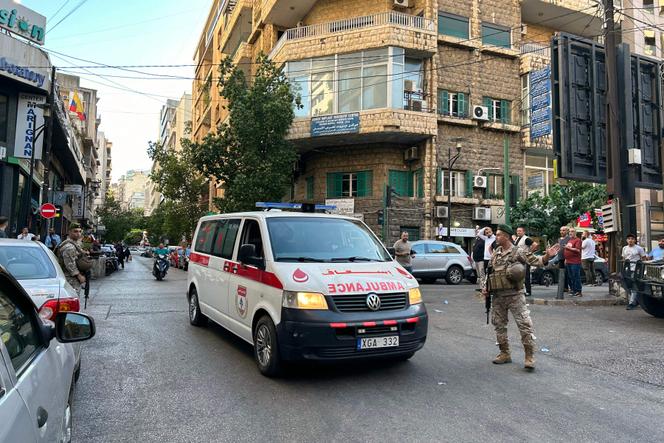According to Lebanon’s health minister, eight people were killed and some 2,800wounded in pager explosions across the country on Tuesday. Hezbollah accused Israel of responsibility.

Lebanese Health Minister Firass Abiad said nine people were killed and some 2,800 wounded in simultaneous pager explosions across the country on Tuesday, September 17, with Hezbollah earlier saying the pagers were used by its members. The blasts “killed eight people, including a girl”, he told a televised press conference. “About 2,750 people were injured… more than 200 of them critically” with injuries mostly reported to the face, hands and stomach, he added.
Hezbollah blamed Israel for the blasts and warned it would be punished. “We hold the Israeli enemy fully responsible for this criminal aggression,” the group said in a statement, adding that Israel “will certainly receive its just punishment for this sinful aggression.”
There was no immediate comment from the Israeli military on the blasts, which came just hours after Israel announced it was broadening the aims of the war sparked by Hamas’s October 7 attacks to include its fight against Hezbollah along its border with Lebanon.
Among the dead were the son of a Hezbollah lawmaker and the 10-year-old daughter of a member of the group. The girl was killed when her father’s pager exploded as she was standing beside him, her family and a source close to Hezbollah said. Iranian state television reported that Tehran’s ambassador in Beirut Mojtaba Amani suffered “superficial” injuries in one of the explosions.
Fourteen people were also in Syria on Tuesday when pagers used by Hezbollah exploded, a Britain-based war monitor said. “Fourteen people whose nationalities are unknown have been wounded in Damascus and its countryside after pagers used by Hezbollah exploded,” the Syrian Observatory for Human Rights said.
The afternoon blasts hit several Hezbollah strongholds across Lebanon, in the first such incident since the group began trading near-daily fire with Israel in support of ally Hamas.
‘Military action’
Earlier Tuesday, Israel announced it was broadening the aims of the war sparked by the Hamas attacks to include its fight against Hezbollah along its border with Lebanon. To date, Israel’s objectives have been to crush Hamas and bring home the hostages seized by Palestinian militants during the October 7 attacks that sparked the war.
“The political-security cabinet updated the goals of the war this evening, so that they include the following section: the safe return of the residents of the north to their homes,” Israeli Prime Minister Benjamin Netanyahu’s office said in a statement.
Partner service
Learn French with Gymglish
Thanks to a daily lesson, an original story and a personalized correction, in 15 minutes per day.
Try for free
Since October, the unabating exchanges of fire between Israeli troops and Hamas ally Hezbollah in Lebanon have forced tens of thousands of people on both sides of the border to flee their homes Not formally declared as a war, the exchanges of fire between Israeli troops and Hezbollah have killed hundreds of mostly fighters in Lebanon, and dozens on the Israeli side.
Hezbollah had instructed its members to avoid mobile phones after the Gaza war began and to rely instead on its own telecommunications system to prevent Israeli breaches.
On Monday, Israeli Defence Minister Yoav Gallant warned that failing a political solution, “military action” would be “the only way left to ensure the return of Israel’s northern communities.”
Hezbollah, which like Hamas is backed by Israel’s regional arch-foe Iran, claimed a dozen attacks on Israeli positions on Monday and three more on Tuesday. Before the wave of pager explosions, Israel said it had killed three Hezbollah members in a strike on Lebanon.
Le Monde with AFP
Vous pouvez lire Le Monde sur un seul appareil à la fois
Ce message s’affichera sur l’autre appareil.
-
Parce qu’une autre personne (ou vous) est en train de lire Le Monde avec ce compte sur un autre appareil.
Vous ne pouvez lire Le Monde que sur un seul appareil à la fois (ordinateur, téléphone ou tablette).
-
Comment ne plus voir ce message ?
En cliquant sur « » et en vous assurant que vous êtes la seule personne à consulter Le Monde avec ce compte.
-
Que se passera-t-il si vous continuez à lire ici ?
Ce message s’affichera sur l’autre appareil. Ce dernier restera connecté avec ce compte.
-
Y a-t-il d’autres limites ?
Non. Vous pouvez vous connecter avec votre compte sur autant d’appareils que vous le souhaitez, mais en les utilisant à des moments différents.
-
Vous ignorez qui est l’autre personne ?
Nous vous conseillons de modifier votre mot de passe.
Lecture restreinte
Votre abonnement n’autorise pas la lecture de cet article
Pour plus d’informations, merci de contacter notre service commercial.
